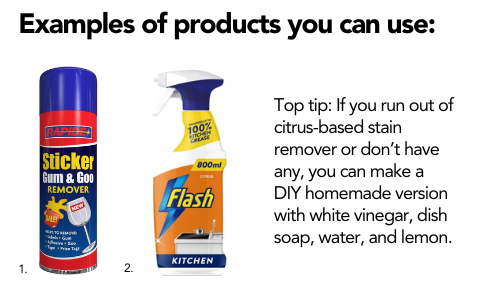
Avoiding charges for Blu Tack and strip/fairy lights
If your landlord can prove that marks left on your walls were caused by you and not by normal wear and tear, they can legally make deductions from your deposit.
Blu Tack stains are notoriously difficult to remove, which is why in all of our occupation contracts we’ve emphasised the need to completely steer clear of using it. It’s extremely costly to rectify the oily marks and spots where paint has come off. It’s the same with white tack, and sticky strips – the stains they cause will all need to be professionally removed and, in most cases, will call for re-decorating. Due to this, they are a leading cause of deposit deductions.
If you have badly marked your walls (through Blu Tack use, stickers, strip lights or otherwise) then you may be liable for some or all of the bill. We're here to help you avoid these issues and extra costs.
You may have Blu Tack stuck on the walls, and aren't sure where to start when removing it - here's what you should do:
- Roll it slowly from the edges: Start at the top and roll the Blu Tack down slowly from the edges into a cylinder-like shape. This method avoids pulling off paint or wallpaper and leaves no sticky residue behind.
- Blot it with Blu Tack: If there's still residue left behind, use the piece of Blu Tack you removed. Roll it into a small ball and place it in the freezer for a few minutes until it hardens. Then, blot the residue away using the hardened Blu Tack. Remember to be firm, not fast, to avoid damaging the wall paint or wallpaper.
There’s a good chance the oil from the Blu Tack might leave a stain on your wall, in which case, give this a try:
- A citrus based cleaner
- Chewing gum remover
- Lighter fuel
- Sugar soap
- A clean, dry cloth
- Kitchen paper
- Simply roll away the old Blu Tack remnants, apply a small amount of your chosen cleaning product to a section of the cloth or kitchen paper and dab (don't rub!) the affected area. Do a patch test on an inconspicuous area first, to ensure that your chosen product will not mark the wall.
- Finally, with a clean and dry piece of cloth or kitchen roll, dab over the same area - the oily mark is dissolved and your stain has been lifted!

Links:
- Please don't attempt to touch up the paint! Unless you’ve got the exact colour match, it will likely make things worse.
- Most of the Blu Tack marks we come across are from photo/poster collages. We know plain walls are boring…but you can make a house a home without Blu Tack. Try attaching string to doors and shelving, then clipping photos and posters to this to achieve the same decorative look.
How to remove your strip lights or fairy lights without damage:
- Test a small area: Make sure the lights are switched off. Before removing the entire string of lights, test a small area of the tape's adhesion. Select an inconspicuous spot on the wall and gently lift the tape to see how it reacts. This will give you an idea of the tape's stickiness and whether it may cause any damage during removal.
- Heat the tape: If the tape seems firmly stuck to the wall, you can try applying heat to soften the adhesive. Use a hairdryer on low to medium heat and direct the warm air towards the tape. Move the hairdryer in a back-and-forth motion while keeping it a few inches away from the wall. The heat should help loosen the adhesive.
- Slowly peel off the tape: Starting at one end of the tape, slowly and gently peel it away from the wall. Pull at a low angle, parallel to the wall, rather than straight out from the wall. Applying steady and even pressure can help prevent damage.
Still left with residue from these or from any stickers or sellotape? Here are some tips on how to remove it:
- Very gently scrape off as much as possible with a credit card or other flat object. Be careful not to scrape too hard, as this could damage the paint.
- If there is any remaining adhesive, apply a bit more heat to it with a hair dryer or heat gun. This will help to loosen the adhesive and make it easier to remove.
- Mix a small amount of mild detergent or dish soap with warm water. Moisten a cloth with the soapy water and gently rub the residue in circular motions. If the soapy water doesn't work, you can try using a vinegar solution. Mix equal parts of white vinegar and water. Dampen a cloth with the solution and gently rub the residue. If it is stubborn, you can apply the chosen solution directly and let it soak for a few minutes.
- Once the adhesive is removed, dampen a cloth and wipe the area then dry the wall with a clean, dry cloth. This will remove any remaining residue and prevent it from attracting dirt and dust.
